
Pretty good interview. You should glean what his philosophy is from this.
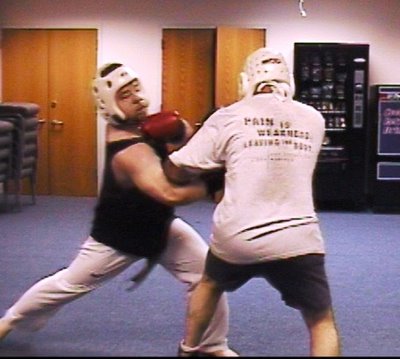
Caution:Body punches may not be the most appropriate tactic. It depends on the rules of the fight and/or skills or your opponent.
A Muay Thai fighter, for example, may find it very easy to land a damaging knee or elbow to your cranium should you attempt a body punch because you have to drop your head). A wrestler may take advantage of this same situation. There are, however, many times when body punches are quite appropriate and useful.

'Hock I am writing to you, because you have made a case against head butts. I am a certified instructor under ____ _____ and his Filipino Concepts. As you know from personal experience, ____ emphasizes head butts. I am also a police officer in _______, Indiana. One night I interrupted a burglary of a pharmacy. A crew was at work and they posted a lookout on the street. I questioned the lookout. He had no answers for my questions and I attempted to arrest him him. A fight ensued. We grappled each others arms. I got his his head and had a clear head butt and tried to drive my head into his nose...
When I woke up. I was down on the sidewalk. Hock, both my pistol and badge were taken from my body. The burglars escaped. They did not finish the burglary, but they got away with my badge and gun. I realize that I had knocked myself out when trying to use my head to hit his head.
This has been a joke at my department. Once at a pistol qualification the guys taped a helmet to my target. Like I would use a head butt instead of a bullet. I could have been killed! I had practiced and simulated head butts for years, never really doing one. Now I know what happens when I really do one! Never again ! We have never recovered my gear.'[And "God did not make your head to be an impact weapon!" - W. Hock Hochheim]
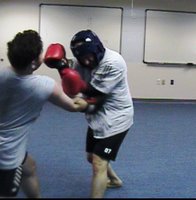 First of all, get your mind out of the gutter!
First of all, get your mind out of the gutter!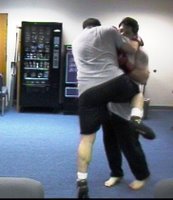
Give it a shot! [Sorry, I couldn't help it!]
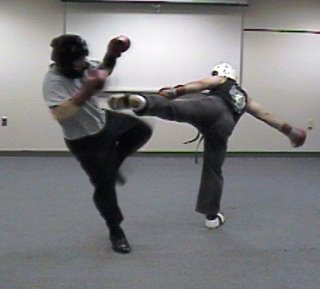
Afghan Christian Should Be Released SoonGive thanks!
KABUL, Afghanistan (AP) -- A court on Sunday dismissed the case against an Afghan man facing possible execution for converting from Islam to Christianity, officials said, paving the way for his release.
 Seems like a pretty good boxing training site. Check it out.
Seems like a pretty good boxing training site. Check it out.
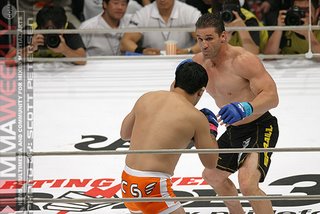
How do you like it? Any suggestions?

Critical information. Please read and share it.... I'm not talking about poodles or puppies; I'm talking about full-grown Rottweilers, pit bulls and Dobermans. If a policeman has to discharge an entire clip into a charging pit bull to stop one, do you think your kicks and punches can do the same? Wake up and smell the red meat, it could be yours!
... most people really don't understand how deadly a dog can be let alone a pack of dogs. They assume a few kicks will do the trick, when in fact that will only hasten their demise.
First - If you ever come across any martial arts instructor who claims he can successfully defend himself from a serious dog attack, do yourself a favor and run for your life. This is a dangerous person and he is teaching dangerous concepts. The reality is, all you can do is to attempt to escape without too much damage.
The following headlines (from 2001-2002) reflect a rising trend in lethal dog attacks.
"Stray dogs kill mother of five" Chukhotka, Russia
"Woman devoured by dog, Moscow" Russia
"Rottweiler kills 3-year-old, Chicago" USA
"Rottweiler savages boy in street" Manchester, England
"Pit Bull attacks German Shepard and owner" San Francisco, USA
"Man killed by his Tosa fighting dogs, Ibaraki" Japan
"Man fends off dog and is knife-attacked by its owner" Drachten, Holland
"Baby girl mauled by Rottweiler" Chicago, USA
"10-year-old girl attacked by police dog, Jacksonville" Florida
"Hunting dogs kill disabled retiree" Kagoshima, Japan
... The most commonly reported dog breeds involved were pit bulls, followed by rottweilers, and German shepherds. ... many breeds, however, are involved in the problem.
Young children are often the most vulnerable to these attacks. Children are small people; they are closer to dog size. So the dog often views them as playmates. In dog society there is a distinct rank order, and dogs sometime see a young child as someone they can push around or perhaps discipline by biting or nipping.
... On the basis of both reputation and dog-attack statistics from the centers of Disease Control and Prevention, the most dangerous dogs listed include Rottweilers, Dobermans, pit bulls, Presa Canarios, chows, Akitas, huskies and wolf hybrids.
Some important things to know
- Sadly, every year a number of newborn infants die when they are bitten by dogs that see them as prey, teach your children the essential rules about avoiding strange dogs. Also, teach them not to tease, chase or throw things at dogs behind fences or gates.
- A real danger with dog attacks is when they start biting your legs, at some point you may lose enough blood and go into shock, where you may well drop to the ground and a dog can finish you off there. Always place something between you and the dog's teeth, plan an escape.
- Dogs are generally motivated by motion…running dogs, children on bicycles, a squirrel etc. They are also motivated by noise, and are more likely to bite when a person yells or screams.
- Always keep in mind that a dog that doesn't know you may see you as an intruder or as a threat.- Avoid going onto private property unless specifically invited.
- If you are bitten or attacked by a dog, take steps to minimize the damages. As soon as possible, wash the wound thoroughly with soap and warm water and then call your regular doctor for additional information on how to treat your wounds. If your wounds are serious enough, go directly to your local emergency room.
 A FightingArts.com opinion piece on training as if your life depended on it, and the limitations of some styles' training for the "real world."
A FightingArts.com opinion piece on training as if your life depended on it, and the limitations of some styles' training for the "real world."When you study a single art you are often confined. It is sort of like the old saying, "when your only tool is a hammer, you just see nails." This is not to say that studying a single art is wrong, but it does suggest that by studying other arts, a student's perspective and experience is broadened so that his understanding and practice of his original art greatly benefits too.
... In Buffalo, my house mate Joel was a full contact grappler and UFC veteran. In my garage, which had been modified into a training center, we often sparred. I still remember the first time I lifted my knee to block a low roundhouse kick. Bam, I was on the floor on my back and wondering what had happened. I quickly learned that a low roundhouse kick was the perfect set up for a take down. I learned to adjust my fighting tactics.
The same lesson holds for self-defense situations. Too many karate-ka never experience actually being attacked to the head. It makes sense for safety reasons not to make contact to the head with punches during karate practice, but this also creates a problem for the same karate-ka if they find themselves in a real fight with someone trying to take their head off. Here again a little cross training adds a lot.
The same problem is even more evident in Aikido and in many jujutsu systems. In Aikido, for example, attacks are done slowly at first, with increased speed and intensity with experience. The emphasis is on cooperation with your partner so you can both learn. But, too often practice is never taken beyond this point. There are teachers who have never had any combat experience, either from karate, boxing or other arts. While their technique may look good, they can unfortunately be at a disadvantage if they had to actually use their art in a real self-defense situation.
A friend Oscar Ratti, best known for his book "Aikido and the Dynamic Sphere," related to me a tragic story of a New York City black belt in Aikido he had known. This person returned to his van after practice one night to find someone rummaging through the back of the vehicle. The friend pulled open one of the back doors to challenge the individual. What he got, however, was unexpected. The robber leaped out from the back with a knife in his hand and thrust it out. Unfortunately the Aikido-ka, with countless years of practice of avoiding punches and practice knife stabs with a pivot during practice, did not do so in this instance. It might have been the surprise, or fear -- no one knows. But the result was tragic. He lost his life. Ratti commented, "So many in Aikido just don't train with combat intensity." In this case it resulted in a loss of life.Judo-ka too often are not introduced to striking arts. This is not important if Judo is practiced only as a competitive sport. But if their skills are to be used for self-defense, some striking and/or kicking practice adds a great deal to their training. The same can be said for Brazilian Jujutsu. While the art definitely demonstrated to much of the martial arts world that traditional arts lacked necessary skills in grappling, the art has its own limitations. Similar to Judo, Brazilian Jujutsu exponents can greatly benefit from learning punching and kicking skills.
... The Japanese warrior of old practiced many arts - the sword, knife, Bow and arrow, naginata (curved spear), yari (straight spear) -- often combined with battlefield grappling skills, plus horsemanship and other arts. He was thus well rounded.
It is only in comparatively modern times that martial artists have confined their training to a single art. But many of the masters who founded those arts in fact trained in several. While you may never seek to become a master yourself, you can still be enriched by the concept of cross training that was once the hallmark of the classical warrior.
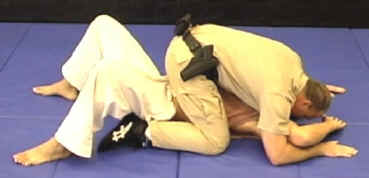
You've survived the first part of the storm and you need put yourself in a position to do any or all of the following:
- Keep him from hitting you, but having the option to hit him if warranted;
- Watch for his friends coming to his aid;
- Disengage if your safety requires;
- Hold him for authorities;
- Handcuff him;
- Submit him.
Then gives the steps:
First, Work for the Mount
Second, Take his Back

Teach:
Demonstrate:
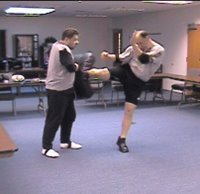 Sam's technique and core (abs and lower back) conditioning contributed to his vastly improved power in the Thai kick!
Sam's technique and core (abs and lower back) conditioning contributed to his vastly improved power in the Thai kick!
 We drilled defending the Thai kick. Notice the turn-in on Sam's kick.
We drilled defending the Thai kick. Notice the turn-in on Sam's kick.
 Protect your head! It's nearly impossible to distinguish between a Thigh kick aimed at the leg, body, or head. Consequently, at kicking range, you must keep the guard high and out. Arm should be at 90-degrees bend or greater. If not, it will be painful!
Protect your head! It's nearly impossible to distinguish between a Thigh kick aimed at the leg, body, or head. Consequently, at kicking range, you must keep the guard high and out. Arm should be at 90-degrees bend or greater. If not, it will be painful!
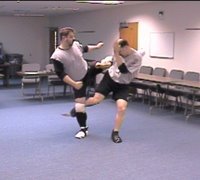 Sam demonstrates the Thai cut kick counter to a medium or high Thai kick. Remember to keep the hands high and out, in case you mis-time it and have to block the kick with your arms, and because when you land, you're in punching range. This is one of the best counters possible to a Thai kick, because, like any stop-hit, it completely shuts down the lead-off move, while simulataneously defending and countering. When done properly, "no can defense!"
Sam demonstrates the Thai cut kick counter to a medium or high Thai kick. Remember to keep the hands high and out, in case you mis-time it and have to block the kick with your arms, and because when you land, you're in punching range. This is one of the best counters possible to a Thai kick, because, like any stop-hit, it completely shuts down the lead-off move, while simulataneously defending and countering. When done properly, "no can defense!"
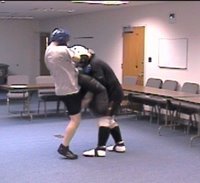 Sam also increased his knee strike power nearly 100%. Pull the opponent's head toward you, and drive the hips as you throw the knee. Sam demonstrates excellent technique here. Notice he's up on the toes of his supporting foot for maximum follow-through.
Sam also increased his knee strike power nearly 100%. Pull the opponent's head toward you, and drive the hips as you throw the knee. Sam demonstrates excellent technique here. Notice he's up on the toes of his supporting foot for maximum follow-through.
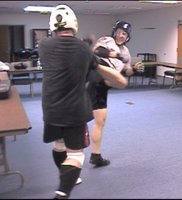 Sam got fancy on me, and even threw a flashy spinning back kick. Being the superior fighter I am, I blocked it, of course. I also bounced off the table visible behind me, but let's not nit pick. He used it at the right time, too - I was visibly winded, and not moving too much. That was a good tactical decision.
Sam got fancy on me, and even threw a flashy spinning back kick. Being the superior fighter I am, I blocked it, of course. I also bounced off the table visible behind me, but let's not nit pick. He used it at the right time, too - I was visibly winded, and not moving too much. That was a good tactical decision.
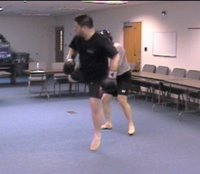 Not to be outdone, I threw in a little flash of my own, and did a jump spinning back kick, one of my all-time favorite techniques. You may notice that I missed, but that's not important. Keep in mind that I didn't want to have to explain Sam's death to Lisa, 'cause I understand he's been teaching her to box and I'm no dummy [quiet!]!
Not to be outdone, I threw in a little flash of my own, and did a jump spinning back kick, one of my all-time favorite techniques. You may notice that I missed, but that's not important. Keep in mind that I didn't want to have to explain Sam's death to Lisa, 'cause I understand he's been teaching her to box and I'm no dummy [quiet!]!
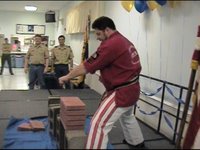
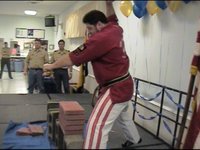
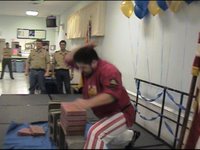
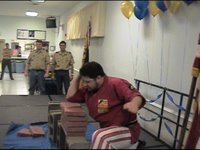
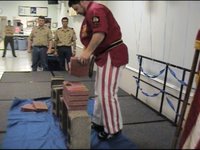 This is a continuation of photos, in order, from the March 5 demonstration I did for the Scouts. What happened here? There were only five slabs! As you can see, they betrayed me, and only one of them broke with the elbow. Actually the break is with the upper arm (you'd shatter the fragile point of the elbow), but what happened is that it was too low. Look at my position on the fourth photo - no follow through. More to come as the battle continues...
This is a continuation of photos, in order, from the March 5 demonstration I did for the Scouts. What happened here? There were only five slabs! As you can see, they betrayed me, and only one of them broke with the elbow. Actually the break is with the upper arm (you'd shatter the fragile point of the elbow), but what happened is that it was too low. Look at my position on the fourth photo - no follow through. More to come as the battle continues...
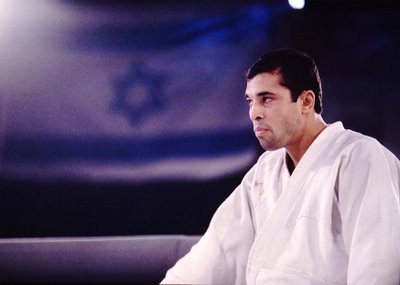
Random thoughts on our training
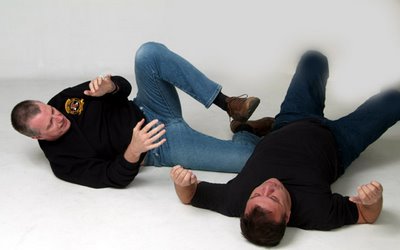
The big four that I believe must be in any practical and modern fighting/survival system. The guidelines I'd like to use.
Strategy Training: This is an overall plan. Big picture. This training can be done in a classroom, in a lecture format. 'Today we are talking about the defeating the mugger.' 'The laws say...' 'He will statistically attack you by...'
Tactical (and practical) Training: These are the general tactics that seem to cross-over into so many applications, such as ...working on a pistol quick draw, slashing a knife, or palm-striking a heavy bag. You might call this basic training.
Situational Training: This requires more study. What are the situations you will be in. Where? This is crisis rehearsal in replications of scenarios. Who are you? Where do you think you will be? What will you need to make through? You might call this the start of advanced training.
Positional Training: This is pinpoint right down to it. The general tactics may well work here, but where precisely are you and the opponent? This is the real fine tuning of tactics as needed. The finite situation. Like...bottom-side ground and his left leg is out. Arm Wrap trap or your knife hand/arm warp trap of his empty hand. His left hand is on your throat and you are up against a wall. Sometimes, solutions relate to finite positioning.
Tink about these terms for a minute and the progression from macro to micro. When you oversee the military, the police and/or civilians, this is volumes of information. "
 Have you ever heard of Max 'Slapsie Maxie' Rosenbloom? If you have, it's because you're a lover of boxing history and lore, or you're an aficianodo of old films. Either way, this former (1932) world light-heavyweight champion's legacy to me is the proof of the effectiveness of the slap!
Have you ever heard of Max 'Slapsie Maxie' Rosenbloom? If you have, it's because you're a lover of boxing history and lore, or you're an aficianodo of old films. Either way, this former (1932) world light-heavyweight champion's legacy to me is the proof of the effectiveness of the slap!IMDB biography:
He was 5' 11" and weighed 165-170 lbs during the peak of his professional boxing years (which included 289 fights). In years to come the larger-than-life Maxie Rosenbloom would parlay his sports fame into an expansive Hollywood career playing a series of Runyonesque-type thugs and pugs. Born Max Everitt Rosenbloom in Connecticut, the son of an impoverished Russian-Jewish shoemaker and his wife, Maxie was a truant and upstart from the beginning. An older brother (who fought under the name Leonard Rose) helped straighten him out and influenced him to try jabbing away at his own career. The lackluster amateur once called the "Harlem Harlequin" lost most of his matches, working odd jobs as a railroad worker, lifeguard and elevator operator to support himself.Everything turned around for Maxie after he became managed by seasoned Frank Bachman and turned pro in 1923 as a welterweight. He won all of his first thirty-six professional fights in various weight divisions. He reached his peak from 1930, after winning the light heavyweight belt in a decision against Jimmy Slattery, to 1932, when he earned international recognition as champion in a decision against Lou Scozza. Dubiously nicknamed "Slapsie Maxie" by sportswriter Damon Runyon who disapproved of Maxie's less-than-classy style of slapping opponents with open gloves, he is considered the most active champion in contemporary boxing history with a fighting total of 106 while champion (only eight, however, were for the title).
http://www.cyberboxingzone.com/boxing/slapsie.htm
Rosenbloom was a clever boxer who was very difficult to hit cleanly with a power punch; He chose to fight at a distance since he was not a devastating hitter; At times, he appeared to strike his opponents with open gloves and, so, picked up the nickname "Slapsie Maxie." A popular fighter, Maxie got into entertainment after retiring from the ring and was invloved with radio, television, movies and night clubs. Rosenbloom was elected to the Ring Boxing Hall of Fame in 1972 and the International Boxing Hall of Fame in 1993.http://en.wikipedia.org/wiki/Max_Rosenbloom
http://www.jewsinsports.org/profile.asp?sport=boxing&ID=9
 "Ultimate Fighter" on Spike TV. As I get more info on his friend, I will post on it, and try to follow the season. Brian tells me that his friend's a heavyweight, and feels that he could've done very well this last season, but had to refuse the invitation because of the birth of his child. More on that later.
"Ultimate Fighter" on Spike TV. As I get more info on his friend, I will post on it, and try to follow the season. Brian tells me that his friend's a heavyweight, and feels that he could've done very well this last season, but had to refuse the invitation because of the birth of his child. More on that later. article cites research published last year which validates something I've been stressing for years - defocus your vision! Key points in the article:
article cites research published last year which validates something I've been stressing for years - defocus your vision! Key points in the article:In a fight or altercation, new research suggests that if you become focused on any object, such as an attacker’s face or on a punching fist, that you might just miss a secondary attack or another attacker altogether.
This same phenomena accounts for that fact that if you are talking on a cell phone or listening to the radio in a car, you are more likely to miss seeing a stop sign or a pedestrian crossing the street. Now we know why this happens. [Study then cited - read it all]
... If we become so focused on an attack or weapon, we might just miss another attack or even another attacker.
This concept is not new, but it is now better explained. As a teacher of karate, I have always instructed students not to focus on the attack when facing an opponent (2), but to look beyond the attack so as to ascertain the next move or attack. I knew that when visually focusing on one thing that it takes time switch back the eye’s focus to a more general awareness so as to pick up secondary attacks.
This is not to suggest that you never concentrate intentionally on an opponent. Before conflict begins or is initiated, if there is a single opponent, it can be helpful to look at an opponent’s eyes while still maintaining a general focus. I have found that in this way I can pick up slight, unconscious changes in the eyes just before an opponent initiates movement. This can help you respond faster since you can have a slight forewarning of an impending attack. Once conflict is initiated, however, only a non-focused general awareness should be maintained.My response:
Defocus your vision from any particular part of your opponent, and watch the entire body. You'll 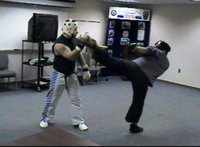 notice right away that you can react more quickly because of the increase in lead time between the attack and your response.
notice right away that you can react more quickly because of the increase in lead time between the attack and your response.
Position your guard so that your hands don't get in the way of seeing the stance and feet of your attacker. If he bends his knees and shifts his weight forward, he may be getting ready for a takedown or strike. If he shifts his weight to the side or back, he may be getting ready to kick. Remember, ALL hand-to-hand attacks are a transfer of weight, so that happens in the legs and hips. The only exception to that is the finger jab, and even then the attacker has to transfer weight when closing the gap (moving into range).
Think ahead of what your opponent is doing right now, and focus on where he is moving or shifting his weight. You have to defocus to do this. What I mean is that If an opponent is moving to his right, you may not have to worry about his right hand or leg, but focus on what he can do with his left (hand or leg).
Enough for now. Please read the article if you have time.
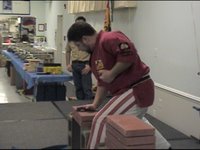 1. Measure distance (like the jab in a 1-2)
1. Measure distance (like the jab in a 1-2)  2. Chamber, straighten the legs
2. Chamber, straighten the legs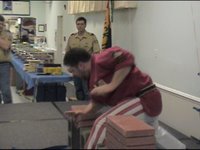 3. Drop the weight, torque the waist, hips, and turn the shoulder in
3. Drop the weight, torque the waist, hips, and turn the shoulder in 4. Follow through (the most important thing!)
4. Follow through (the most important thing!) One of my most beloved striking arts is Muay Thai, the ancient sport that's actually a deadly fighting art. To me, what makes it practical (besides the deadly techniques) is that it is a sport!
One of my most beloved striking arts is Muay Thai, the ancient sport that's actually a deadly fighting art. To me, what makes it practical (besides the deadly techniques) is that it is a sport!I have trained in:
Tae Kwon Do (WTF and ITF) 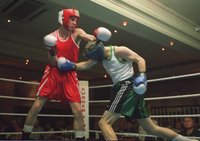
Isshin-Ryu
Taido
Wrestling (freestyle)
Aikido (Yoshin)
Muay Thai (Thai Boxing)
Western Boxing
Wing Chun (Canton-style)
Arnis (Doce Pares)
Ju-Jitsu* (Wally Jay's Small Circle and traditional, no Brazilian) 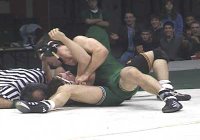
Judo*
*Limited (less than a year)
I relate this to tell you that the styles that make up the core of what I use are Muay Thai, Western Boxing, and a mixture of Aikido and Ju-Jitsu technique. In other words, my core styles are sports (boxing and Muay Thai). Why?
The advantage of Muay Thai training methods and competition, to me, is that it's closer to a "real fight" than anything I've seen in a Karate or TKD match. There is full contact, continuous fighting (no stoppage of action after a score), fighting in all hand to hand ranges, and knockouts. It develops the ability to get hit without freezing, then fire back without thinking. Plus it develops a "killer instinct" to hit first, hard, and finish off a stunned opponent. Those aspects don't exist in most martial arts that don't have a sport component. Even sport TKD builds that fighting instinct, though it doesn't allow much practical punching.
One of the problems with more esoteric styles is that you never "use" it. For example, I've seen many Aikidoka that are so steeped in their system, and only train against it, that they'd have trouble with someone that's untrained, but may be very good against "traditional" technique. In other words, they can't fight. There are exceptions, of course, but if you asked me to bet on a college wrestler versus an Aikido practitioner, I'd take the wrestler. [I'm betting on some hate mail here] Same with some traditional Karate and Kung Fu - you'd have to adapt it to make it work.
Take the UFC as an example. In the beginning two years or so, maybe less, the big thing was to put the different styles in the octagon, and "see what happened!" Well, a few UFCs later, what happened was that the styles blended, and now it doesn't make too much difference. (The only problem with this example is that the padded ring slants it toward takedowns and grappling, then the introduction of gloves made it a punching, not open-hand striking sport. I understand both, 'cause it makes for a more exciting "fight," though it takes the real out of the so-called-reality fighting.) Anyway, why were the Gracies and other grappling sports so successful versus the more traditional styles - practice. Those from other styles that compete a lot - kickboxing/full-contact, wrestlers, Judo players, Sombo and MMA/submission fighting - did very well, too. The only competitive styles that I haven't seen be really successful have been boxing and Sumo, because I think they are too far removed from what happens in the Octagon.
Anyway, I read an introduction in a Gracie Jujutsu book that explained it this way (I am paraphrasing from memory):
What that tells me is that 1) those who use their technique often in competition will be able to use it under stress, as in an attack, and 2) the stress of competition probably prepares one for a similar stress in an attack better than punching at air or doing pre-arranged drills all the time.
Do you agree?
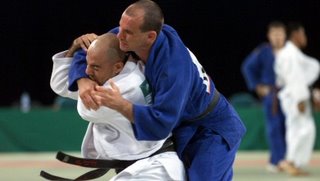
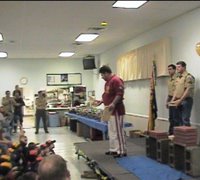 Don't try this at home kids!!!
Don't try this at home kids!!! See these knuckles? They're about to hurt!
See these knuckles? They're about to hurt!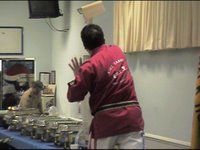 Now it hurts!
Now it hurts!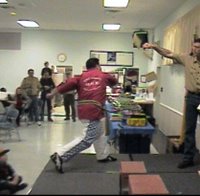 Speed ridgehand through three boards. Ouch!
Speed ridgehand through three boards. Ouch! Knifehand through three boards.
Knifehand through three boards.

In my training I am always preparing for the 3%’r. That sociopath who’s intent is to kill or maim you, someone who might not be feeling any pain due to adrenaline or the effects of drugs. When training my students for this most dangerous of individuals I needed a reframe. I needed words that would convey the correct mindset in my training. Two phrases emerged. Subdual Fighting, and Survival Fighting.
To subdue is defined as “to conquer and bring into subjection, to bring under control especially by an exertion of the will.” It is something we do to our opponent. As a police officer, when I encountered resistance, I had to subdue more suspects than I had submit.
Consider this deeply, if the person you are fighting has no intention of submitting, you must subdue him. It will take an imposition of your will over that of your opponent to win. How does this change the way you look at your “favorite” tactic? How does it affect the way you train? How does it affect the way you teach?

The Iraqis nurture their children, and although some could definitely use better
medical attention, the most profound and far-reaching help that the average citizen of a developed country can do for Iraqi children is to facilitate their education. These kids are the greatest hope for improving the region, and while some far-thinking people see this, I have yet to see a library in an Iraqi school.
I’ve seen the U.S. Army hold medical screenings, build schools and playgrounds, deliver sporting gear, and so on, but much of the help for Iraqi kids is coming from Joe Citizen, who has never been to Iraq, through a program started when one not-so-ordinary citizen traveled there and saw the immediate need.
While on a USO tour of Iraq in 2003, Gary Sinise recognized the potential as well asthe plight of these children. Once back in the United States, he joined forces with a couple of smart and good-hearted people, Laura Hillenbrand and Mary Eisenhower, and took action to address the educational needs of Iraqi kids. In what he describes as “a few breathtaking and exhausting weeks,” these three dynamos organized Operation Iraqi Children(OIC).
Gary often remarks that it was the experience of watching school children trying to learn in squalid conditions with few books or school supplies that moved him to work with Mary and Laura, pooling their clout and resources to form Operation Iraqi Children.FedEx delivers to several cities in Iraq, including Baghdad, Mosul, and Balad. To their great credit, FedEx ships for Operation Iraqi Children all the way to Kuwait, free of charge, and has been doing so ever since OIC’s inception in April, 2004.
For those who wish to bolster the morale of our troops while enhancing the educational experience of Iraqi kids, please visit the OIC website, and put that good will into action.
http://www.operationiraqichildren.org/